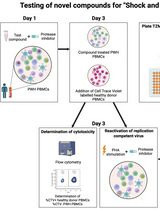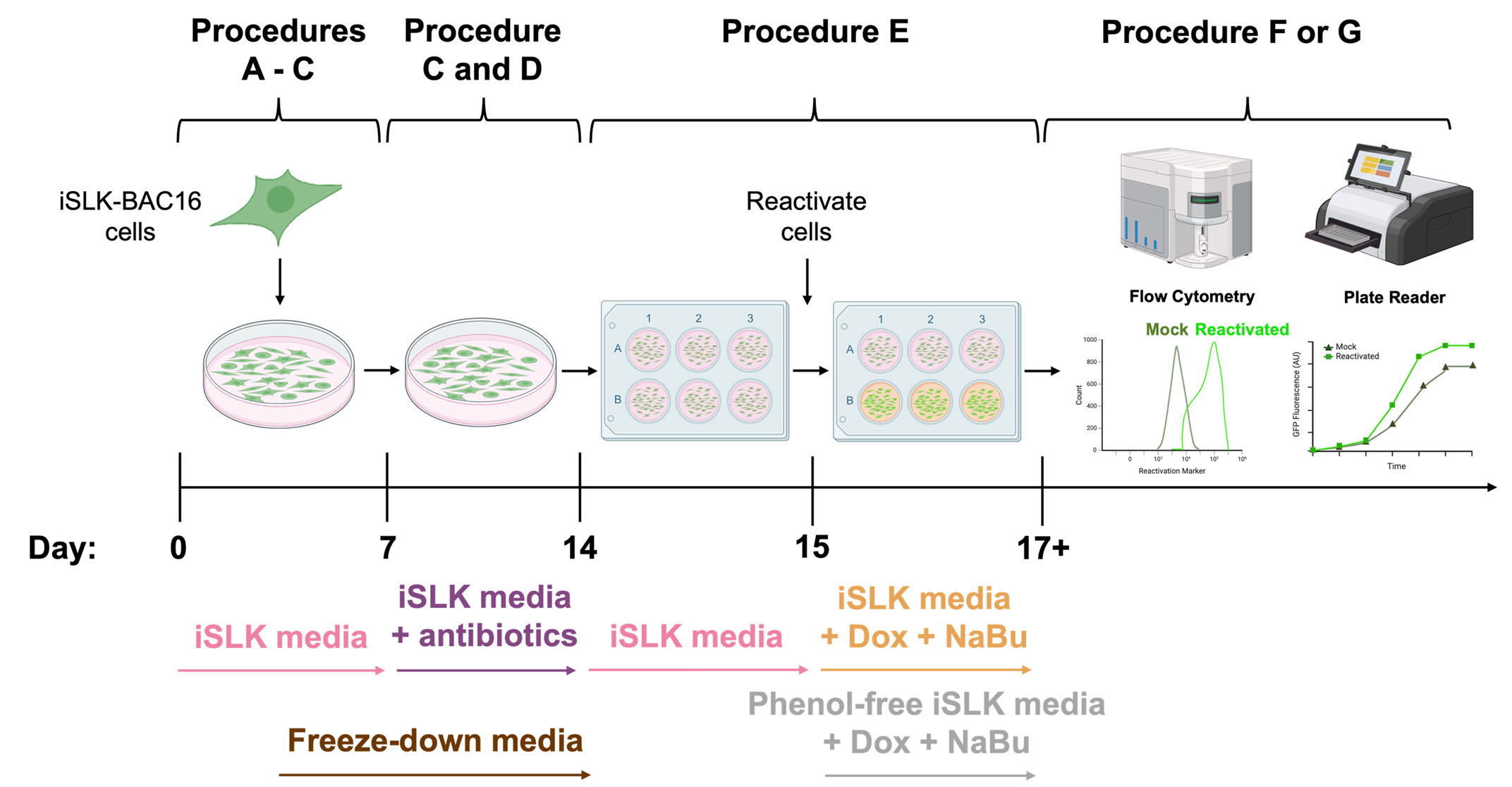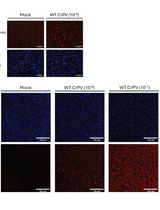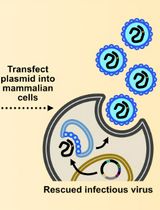- EN - English
- CN - 中文
General Maintenance and Reactivation of iSLK Cell Lines
iSLK细胞系的常规维护与KSHV再活化操作
(§Technical contact: Ariana.Calderon_Zavala@tufts.edu) 发布: 2025年06月05日第15卷第11期 DOI: 10.21769/BioProtoc.5334 浏览次数: 1231
评审: Samantha HallerAnu ThomasAnonymous reviewer(s)

相关实验方案

诱导型HIV-1库削减检测(HIVRRA):用于评估外周血单个核细胞中HIV-1潜伏库清除策略毒性与效力的快速敏感方法
Jade Jansen [...] Neeltje A. Kootstra
2025年07月20日 1566 阅读
Abstract
Since the establishment of the iSLK-BAC16 cell culture system, iSLK-BAC16 cells and their derivatives have been widely used for Kaposi’s sarcoma-associated herpesvirus (KSHV) studies. However, iSLK-BAC16 cells can be difficult to work with, in part due to the lack of standardized protocols and conflicting troubleshooting suggestions. Here, we describe the protocol for general iSLK-BAC16 cell culture and reactivation, which induces lytic KSHV replication and virion production. This protocol achieves robust levels of KSHV reactivation in our hands and can be readily used for studies of KSHV lytic infection mechanisms.
Key features
• This protocol describes methods for culturing and antibiotically selecting iSLK-BAC16 cells for robust KSHV reactivation.
• Use of flow cytometry to quantify KSHV reactivation rates.
• Innovative use of automated plate readers to assess KSHV reactivation.
Keywords: KSHV (KSHV)Graphical overview

Schematic overview of the procedures used for general iSLK-BAC16 cell culture and Kaposi’s sarcoma-associated herpesvirus (KSHV) reactivation of iSLK-BAC16 cells. A typical timeline of iSLK-BAC16 cell culture, antibiotic selection, KSHV reactivation, flow cytometry quantification, and plate reader assessment of KSHV lytic replication. Corresponding media requirements are denoted under the respective procedures. iSLK-BAC16 = doxycycline-inducible endothelial cells harboring the KSHV genome on an artificial bacterial chromosome; Dox = doxycycline; NaBu = sodium butyrate.
Background
Kaposi’s sarcoma-associated herpesvirus (KSHV), also known as human herpesvirus-8 (HHV-8), is a member of the Gammaherpesvirinae subfamily of the Orthoherpesviridae family, commonly known as herpesviruses. KSHV can infect lymphocytes and endothelial cells, causing Kaposi’s sarcoma (KS), primary effusion lymphomas (PELs), and multi-centric Castleman’s disease [1–4]. Mechanisms of latent and lytic KSHV infection are commonly studied in in vitro cell culture using the doxycycline-inducible SLK (iSLK) cell culture system because its design allows for a tight control of KSHV latent and lytic replication stages. iSLK cells originate from uninfected SLK (endothelial) cells, derived from a patient with a gingival KS lesion [5]. These iSLK cells were latently infected with rKSHV.219 [6], a KSHV strain isolated from JSC-1, a PEL-derived KSHV-positive cell line [7], and selected for successful integration of the rKSHV.219 genome using puromycin [8]. To tightly control the switch from KSHV latency into the lytic program, iSLK.219 cells were engineered to express RTA (the KSHV lytic transactivator) under the control of a tetracycline (tet) operator (selected with hygromycin). RTA expression can be induced using the reverse, tetracycline-controlled transactivator (rtTA) Tet-On system (selected with G418). Upon doxycycline (Dox) treatment, RTA gene expression is initiated, and the KSHV lytic gene expression program is activated, resulting in robust viral gene expression and viral replication [8]. Of the established iSLK cell lines, the most commonly used are iSLK-BAC16 cells and their derivatives, which harbor the rKSHV.219 genome on a bacterial artificial chromosome (BAC16) but retain the Dox-inducible RTA system [9]. iSLK-BAC16-cells constitutively express GFP as a marker for the Dox-inducible RTA system, yet can be engineered to express additional fluorescent reporters [10–12]. The use of fluorescent reporters in iSLK-BAC16 cells facilitates monitoring cells during antibiotic selection to enrich for those containing the KSHV genome.
The present protocol describes the procedures for general maintenance of iSLK-BAC16 cell cultures and appropriate antibiotic selection of iSLK-BAC16 cells harboring the Dox-inducible RTA system to achieve robust KSHV reactivation (~90%), as opposed to the large variation (40%–80%) observed in previous studies [9–10,13]. Although this protocol was developed on the basis of methods described in [9–11], it provides details lacking in prior protocols, including cell density requirements prior to and during antibiotic selection, target antibiotic concentrations necessary to maintain the Dox-inducible RTA system, and optimal cell density requirements for robust KSHV reactivation. Using an automated plate reader and flow cytometry, we assessed and quantified KSHV reactivation rates by detecting fluorescent reporters for latent and lytic infection [9–11]. The procedures in this protocol can be applied to other iSLK-BAC16 cell derivatives.
Materials and reagents
Biological materials
1. iSLK-BAC16 (a gift from Jae Jung, Cleveland Clinic, Lerner Research Institute)
a. Encodes a constitutively expressed GFP transgene (green)
2. iSLK-BAC16-mIFP2-ORF57pr-EGFP cells [10] (a gift from Britt Glaunsinger, University of California, Berkeley)
a. Encodes a constitutively expressed mIFP2 transgene (far-red)
b. Encodes an EGFP transgene (green) driven by the immediate early viral gene promoter, ORF57, and expressed upon Dox induction
3. iSLK-BAC16-HaloTag-ORF68 cells [11] (a gift from Britt Glaunsinger, University of California, Berkeley)
a. Encodes a constitutively expressed GFP transgene (green)
b. Encodes an N-terminal HaloTag fused to the early viral gene, ORF68
c. Upon Dox induction, ORF68-Halo is expressed, which is detected by the addition of Janelia Fluor-646 HaloTag ligand (orange or far-red)
Reagents
1. Fetal bovine serum (FBS), heat-inactivated (Biowest, catalog number: S1680), store at -20 °C
2. GlutaMAX, 100× (Gibco, catalog number: 35050061), store at 4 °C
3. Penicillin-streptomycin, 100× (Cytiva, catalog number: SV30010), store at 4 °C
4. DMEM, high glucose, (+) L-glutamine, (-) sodium pyruvate (Gibco, catalog number: 11965-118), store at 4 °C
5. Trypsin, 0.05%, 1× (Cytiva, catalog number: SH30236.01), store at -20 °C
6. Phosphate buffered saline (PBS) 1× (Cytiva, catalog number: SH30256.01), store at room temperature
7. Trypan blue solution (Cytiva, CAS number: 72-57-1), store at room temperature
8. Dimethyl sulfoxide (DMSO) (Corning, catalog number: 25-950-CQC), store at room temperature
9. Isopropanol (Fisher Scientific, CAS number: 67-63-0), store at room temperature
10. Hygromycin B in PBS (AG Scientific, CAS number: 31282-04-9), store at 4 °C
11. G418 (VWR, CAS number: 108321-42-2), store at 4 °C
12. Puromycin dihydrochloride from Streptomyces alboniger (Sigma-Aldrich, CAS number: 58-58-2), store at 4 °C
13. Doxycycline hydrochloride (Fisher Scientific, CAS number: 10592-13-9), store at 4 °C
14. Doxycycline hyclate (Tocris Bioscience, CAS number: 24390-14-5), store at 4 °C
15. Sodium butyrate (Fischer Scientific, CAS number: 156-54-7), store at 4 °C
16. Janelia Fluor 646 Halo Ligand, 200 μM (Promega, catalog number: GA1120), store in amber tubes at -20 °C
17. Paraformaldehyde (PFA) in PBS, 4% (Santa Cruz Biotechnology, CAS number: 30525-89-4), store at 4 °C
18. Phenol-free DMEM, high glucose, HEPES, (+) L-glutamine, (-) sodium pyruvate (Gibco, catalog number: 21-063-029), store at 4 °C
19. Bleach (Clorox, catalog number: 30966), store at room temperature
Solutions
1. iSLK general cell culture media (iSLK media) (see Recipes)
2. G418 stock solution in PBS, 10 mg/mL (see Recipes)
3. Puromycin dihydrochloride stock solution in PBS, 1 mg/mL (see Recipes)
4. iSLK selection media (iSLK media + antibiotics) (see Recipes)
5. Freeze-down media (see Recipes)
6. Doxycycline hydrochloride or hyclate stock solution in PBS, 5 mg/mL (see Recipes)
7. Sodium butyrate stock solution in PBS, 1 M (see Recipes)
8. Janelia Fluor 646 Halo Ligand, 20 μM (see Recipes)
9. Phenol-free iSLK cell culture media (phenol-free iSLK media) (see Recipes)
10. Bleach, 20% (see Recipes)
Recipes
1. iSLK general cell culture media (iSLK media)
Store at 4 °C for up to 3 months.
| Reagent | Final concentration | Volume |
|---|---|---|
| DMEM, high glucose, (+) L-glutamine, (-) sodium pyruvate | 1× | 500 mL |
| FBS, heat-inactivated | 10% | 50 mL |
| GlutaMAX, 100× | 1× | 5 mL |
| Penicillin-streptomycin, 100× | 1× | 5 mL |
2. G418 stock solution in PBS (10 mg/mL)
Store at -20 °C for up to 12 months.
| Reagent | Final concentration | Quantity or Volume |
|---|---|---|
| G418 | 10 mg/mL | 10 mg |
| PBS | 1× | 1 mL |
Filter-sterilize using a 0.22 μm syringe filter. Store at -20 °C in 1 mL aliquots. Avoid repeated freeze-thaw cycles.
3. Puromycin dihydrochloride stock solution in PBS (1 mg/mL)
Store at -20 °C for up to 12 months.
| Reagent | Final concentration | Quantity or Volume |
|---|---|---|
| Puromycin dihydrochloride | 1 mg/mL | 1 mg |
| PBS | 1× | 1 mL |
Filter-sterilize using a 0.22 μm syringe filter. Store at -20 °C in 500 μL aliquots. Avoid repeated freeze-thaw cycles.
4. iSLK selection media (iSLK media + antibiotics)
Store at 4 °C for up to 3 months.
| Reagent | Final concentration | Volume |
|---|---|---|
| DMEM, high glucose, (+) L-glutamine, (-) sodium pyruvate | 1× | 500 mL |
| FBS, heat-inactivated | 10% | 50 mL |
| GlutaMAX, 100× | 1× | 5 mL |
| Penicillin-streptomycin, 100× | 1× | 5 mL |
| Hygromycin B in PBS, 50 mg/mL | 1 mg/mL | 10 mL |
| G418, 10 mg/mL | 50 μg/mL | 2.5 mL |
| Puromycin dihydrochloride, 1 mg/mL | 1 μg/mL | 500 μL |
5. Freeze-down media
Store at 4 °C for up to 3 months.
| Reagent | Final concentration | Volume |
|---|---|---|
| FBS, heat-inactivated | 1× | 4.5 mL |
| DMSO | 10% | 500 μL |
6. Doxycycline hydrochloride or hyclate stock solution in PBS, 5 mg/mL
Store at -20 °C for up to 12 months.
| Reagent | Final concentration | Quantity or Volume |
|---|---|---|
| Doxycycline hydrochloride or hyclate | 5 mg/mL | 5 mg |
| PBS | 1× | 1 mL |
Filter-sterilize using a 0.22 μm syringe filter. Store at -20 °C in 50 μL aliquots.
7. Sodium butyrate stock solution in PBS, 1 M
Store at -20 °C for up to 12 months.
| Reagent | Final concentration | Quantity or Volume |
|---|---|---|
| Sodium butyrate | 1 M | 110.09 mg |
| PBS | 1× | 1 mL |
MW: 110.09 g/mol. Filter-sterilize using a 0.22 μm syringe filter. Store at -20 °C in 50 μL aliquots.
8. Janelia Fluor 646 Halo Ligand, 20 μM
| Reagent | Final concentration | Quantity or Volume |
|---|---|---|
| Janelia Fluor 646 Halo Ligand, 200 μM | 20 μM | 10 μL |
| DMSO | 1× | 90 μL |
Halo Ligand is sensitive to light and freeze-thawing. Store in amber tubes at -20 °C in 10 μL aliquots for up to 6 months.
9. Phenol-free iSLK cell culture media (phenol-free iSLK media)
Store at 4 °C for up to 3 months.
| Reagent | Final concentration | Volume |
|---|---|---|
| Phenol-free DMEM, high glucose, HEPES, (+) L-glutamine, (-) sodium pyruvate | 1× | 500 mL |
| FBS, heat-inactivated | 10% | 50 mL |
| GlutaMAX, 100× | 1× | 5 mL |
| Penicillin-streptomycin, 100× | 1× | 5 mL |
10. Bleach, 20%
Prepare fresh before use. Store at room temperature for up to 24 hours.
| Reagent | Final concentration | Volume |
|---|---|---|
| Bleach | 20% | 10 mL |
| Deionized water | 1× | 40 mL |
Laboratory supplies
1. Aspirating pipettes, 2 mL (Celltreat, catalog number: 229262)
2. Pipettes, 5 mL (Celltreat, catalog number: 667205B)
3. Pipettes, 10 mL (Celltreat, catalog number: 667210B)
4. Pipettes, 25 mL (Celltreat, catalog number: 667225B)
5. Filter pipette tips, 10 μL (USA Scientific, catalog number: 1120-3810)
6. Filter pipette tips, 200 μL (USA Scientific, catalog number: 1120-8810)
7. Filter pipette tips, 1,000 μL (USA Scientific, catalog number: 1122-1830)
8. Pipette, P1000 (ErgoOne, catalog number: 7110-1000)
9. Pipette, P200 (ErgoOne, catalog number: 7100-2200)
10. Pipette, P10 (ErgoOne, catalog number: 7100-0510)
11. Centrifuge tubes, 15 mL (Celltreat, catalog number: 229411)
12. Centrifuge tubes, 50 mL (Celltreat, catalog number: 229421)
13. 1 mL Luer-Lok syringe (BD, catalog number: 309628)
14. Syringe filter, 0.22 μm PVDF (Foxx Life Sciences, catalog number: 378-2415-OEM)
15. 150 mm × 20 mm (15 cm) plate, tissue culture treated (Celltreat, catalog number: 229620)
16. 100 mm × 20 mm (10 cm) plate, tissue culture treated (Celltreat, catalog number: 229651)
17. 6-well plate, tissue culture treated (Celltreat, catalog number: 229106)
18. 96-well plate, tissue culture treated, black (Greiner Bio-One, catalog number: 655090)
19. Cryogenic vials, 1 mL (Globe Scientific, catalog number: 3001)
20. Round-bottom tubes, 5 mL (Falcon, catalog number: 352052)
21. Mr. Frosty freezing container (Thermo Scientific, catalog number: 5100-0001)
22. Cell counting (hemocytometer) chamber slides (Invitrogen, catalog number: C10228)
23. Microcentrifuge tubes, 1.5 mL (BioPlas, catalog number: 4030)
Equipment
1. CO2 cell culture incubator (Thermo Scientific, model: Heracell VIOS 160i)
2. Biosafety cabinet (Nuaire, model: NU-425-400)
3. 37 °C water bath (Fisher Scientific, model: Isotemp 228)
4. Benchtop centrifuge (Thermo Scientific, model: ST Plus Series)
5. -80 °C freezer (PHCbi, model: MDF-DU703VH-PA)
6. Liquid nitrogen storage tank (Thermo Scientific, model: Cryoplus 2)
7. Fluorescent microscope (Leica, model: DM IL LED)
8. Analytical scale (Mettler Toledo, model: X5R105DU)
9. Automated cell counter (Invitrogen, model: Countess II)
10. Flow cytometer (Thermo Scientific, model: Attune Cytpix)
11. Automated plate reader (Tecan, model: Spark)
Software and datasets
1. Leica Application Suite X (LAS X) software (Leica, version 3.7.5.24914)
2. Attune cytometric software (Thermo Scientific, version 6.21)
3. FlowJo software (BD, version 10.10)
4. Prism software (GraphPad, version 10.4.1)
Procedure
文章信息
稿件历史记录
提交日期: Mar 20, 2025
接收日期: May 6, 2025
在线发布日期: May 22, 2025
出版日期: Jun 5, 2025
版权信息
© 2025 The Author(s); This is an open access article under the CC BY license (https://creativecommons.org/licenses/by/4.0/).
如何引用
Calderón-Zavala, A. C., Mendez, A. S. and Heldwein, E. E. (2025). General Maintenance and Reactivation of iSLK Cell Lines. Bio-protocol 15(11): e5334. DOI: 10.21769/BioProtoc.5334.
分类
微生物学 > 微生物-宿主相互作用 > 病毒
细胞生物学 > 细胞分离和培养 > 细胞生长
您对这篇实验方法有问题吗?
在此处发布您的问题,我们将邀请本文作者来回答。同时,我们会将您的问题发布到Bio-protocol Exchange,以便寻求社区成员的帮助。
提问指南
+ 问题描述
写下详细的问题描述,包括所有有助于他人回答您问题的信息(例如实验过程、条件和相关图像等)。
Share
Bluesky
X
Copy link











